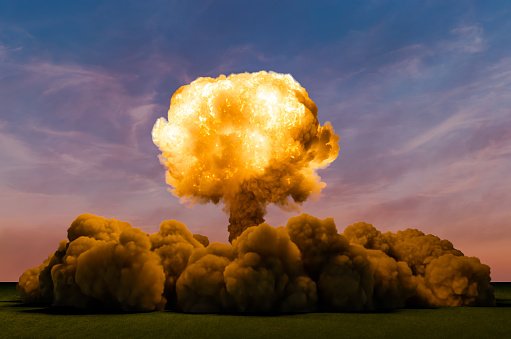With the power to cause havoc and pronounced destruction, the atomic bomb was a contentious invention of mankind. The impact of a mere nuclear reaction took away the lives of many and demolished entire cities (Hiroshima and Nagasaki): the effects of which prevail to date. Possessing a nuclear weapon may signify the power to some; others may beg to differ. Behind closed doors, the study of the radioactivity phenomenon, the behavior of alpha particles, and the properties of materials when irradiated by the “Nuclear Group” formed the basis of the worse that was to come: Atomic Bombs.
“No one who saw it could forget it, a foul and awesome display” – Kenneth Bainbridge
Beginning of an era
A letter of warning from the Nobel Prize laureate Albert Einstein, in October 1939 to Franklin Roosevelt, the US president, hinted at the possibility of Nazi Germans developing a nuclear weapon. The US government launched “The Manhattan Project” on the severity of the issue in August 1942. Major General Leslie Groves led the operation and gathered Ingenious scientists and researchers from across educational institutions and research labs. Private corporations such as DuPont provided all the necessary assistance and components needed to make atom bombs. For safety purposes, the facility was located on the outskirts of the desert in New Mexico.
The intensity and determination to accomplish the project were evident by the fact that, at a point, there were approximately 130,000 Americans across thirty-seven facilities working for the success of the Manhattan project. The first nuclear bomb was tested at a military facility in New Mexico amid the early morning darkness. The impact was significant, and the explosion was bright. Though it might look like an apparent success, using these nuclear bombs was inevitable.
Once it became discernible that Japan would not surrender in the war, Harry S Truman, the president of the United States, ordered the use of nuclear bombs on Japan. Though he was warned by US armed forces that the destruction post-nuclear bomb was inevitable and catastrophic, Truman was determined to ensure Japan’s surrender.
The darkest day
6th August 1945 was a dark day in the history of Japan when an American B-29 bomber, “Enola Gay”, dropped the first atomic bomb on the Japanese city of Hiroshima. The explosion resulted in approximately 140,000 causalities, followed by radiation poisoning that persisted months later. Truman hoped that Japan would surrender after this attack, but Japan did otherwise. The reaction instigated Truman, and he called for another nuclear attack on Nagasaki (Japan), just three days after the first nuclear attack. The second round of bombing resulted in 210,000 people losing their lives with inexorable vandalization.
Wrecked Cities: Hiroshima and Nagasaki
Hiroshima and Nagasaki saw the most devastating aftermath of the nuclear attack, the effects of which still exist. Apart from the pernicious loss of lives, a large population developed medical conditions such as cancer and leukemia post-exposure to radiation. The bombing of Nagasaki caused the surface temperature to rise to 4000 degrees Celsius, followed by a downpouring of radioactive rain. It dismantled 70% of buildings, accompanied by a lack of immediate relief to mitigate the capacity of damage caused.
Several years post the 1945 disaster, the number of patients who developed chronic diseases, blood cancer, respiratory disorders, and DNA mutations increased. Perhaps the children were the greatest group of individuals affected by leukemia. Children became prone to developmental disorders, intellectual disabilities, and stunted growth.
Ramifications of Nuclear Power
When it comes to energy, perhaps one of the most heated debate topics is the provision of nuclear energy and its effects on mankind. Do the perils of Nuclear Energy outweigh its possible benefits? Let’s have a look!
The brighter side
Nuclear power does not produce direct carbon dioxide in terms of energy production. Less carbon dioxide means less contribution to global warming. Moreover, nuclear power plants produce a significant amount of energy at a steady rate which is essential to keep up with the increasing energy demands. Furthermore, the entire setup and development of nuclear power generates jobs and have a higher mean average salary. In addition to this, nuclear power does provide the provision of national security for any country possessing nuclear weapons.
A matter of concern
However, constructing a nuclear power plant requires a lot of energy and manpower. Massive amount of radioactive waste is produced, a side effect of nuclear power plants. This radioactive waste can remain active and release radiation for several years. Workers working in the plant may be exposed to frequent radiation that imparts health problems such as chronic diseases and cancers. The thermal radiation post-nuclear explosion can cause significant skin burns. The shock waves produced as a result of a nuclear explosion can damage the ears and the lungs.
Raidan exposure
Although nuclear power operations are highly organized and tailored for safety protocols, natural disasters (earthquakes), human errors, leakage, and mechanical inconsistencies can cause contamination and release of radioactive matter. For instance, a core meltdown, else known as the “beyond design basis,” causes a reactor to emit radiation (ionizing radiation) into the environment. Workers are at the greatest level of exposure to such radiation and may develop conditions such as acute radiation syndrome (ARS).
Waterbodies at risk!
Environmental impacts of nuclear power are inevitable. Usually, nuclear facilities are located near water bodies (lakes, rivers) as water is needed to cool the nuclear reactors. However, the cooling water, post usage, alters the conditions of the water bodies. Temperature changes in water can affect aquatic life adversely. Water that is too cold or too warm can potentially kill or harm these aquatic beings. It may affect their movement, food availability, feeding patterns, sleep cycle, and the underwater ecosystem.
Underground mining
Moreover, nuclear facilities require uranium for their operation. Uranium is mined, and these mining activities can pollute nearby lakes and underground water, cause loss of habitat, and change soil composition (ph changes). Furthermore, underground mining poses a significant threat to the lives of miners. Vast quantities of radon gas, a radioactive gas, are released during this process which is associated with lung cancer. Dust emitted can result in medical conditions such as pneumoconiosis.
Climate Change
Nuclear plants are highly prone to climatic changes. Alterations in air and water temperature, wind speed, and precipitation rates hamper the efficiency of nuclear facilities and risk their safety. Floods and hurricanes can reduce the water supply to nuclear plants and damage them, causing a decrease in energy production, financial losses, and potential contamination of drinking water supplies.
Explosion Disasters
Post-nuclear explosion, the smoke and dust rise to a higher level of the atmosphere, causing a significant drop in land temperatures by blocking sunlight. Such temperature variations can result in a shorter growing season and potentially decrease overall agricultural production and fish stocks. It is an alarming situation as it can be followed by episodes of famine and food shortages.
As Albert Einstein said:
“The release of atomic energy has not created a new problem. It has merely made more urgent the necessity of solving an existing one”
References:
- https://www.icanw.org/climate_disruption_and_famine
- https://www.icrc.org/en/nuclear-weapons-a-threat-to-humanity
- https://www.energy.gov/ne/articles/advantages-and-challenges-nuclear-
- energy#:~:text=Nuclear%20energy%20protects%20air%20quality,medical%20field%20to%20space%20exploration.
- https://ehistory.osu.edu/articles/story-atomic-bomb
- https://www.khanacademy.org/humanities/us-history/rise-to-world-power/us-wwii/a/the-manhattan-project-and-the-atomic-bomb
- https://k1project.columbia.edu/news/hiroshima-and-nagasaki
- https://www.fws.gov/node/265255
Also, Read: The Radium Girls – A tale of oblivious poisoning

Maira Masood is a BS Biosciences student at NUST, Pakistan. She aspires to be a geneticist and wants to play an active part in spreading scientific awareness through writings.

